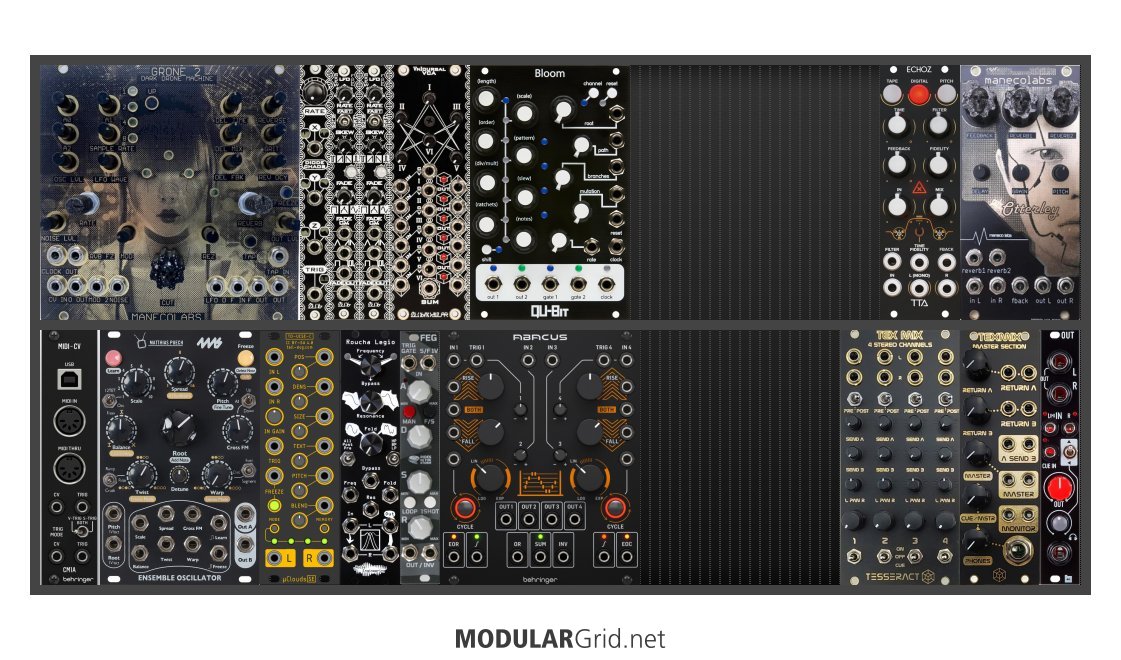a balanced modular tends towards this:
sound sources < sound modifiers < modulation sources < utilities
-- JimHowell1970depending how you count these, I would say my planned rack is not too far from your proportion, depending on how you would count a PAM or a O&C or a Threshold/Edge or many other modules with multiple functions, maybe i should browse the utilities section again and see if i find inspiration there.
It's quite a fluid formula - and open to interpretation - is tides a sound source or a modulation siurce? is a self-oscillating resonant filter a sound source or a sound modifier? I'd usually group things by primary intent within the confines of the rack...
Not all modules are meant to fit in - it's not a comprehensive theory of everything, it's a suggestion of a way to think in order to get the most versatility in patching in a modular for the least expense (& it scales incredibly well - from the smallest rack to Vince Clark proportions) and particularly to steer people away from just buying sound sources and modifiers - there are newbies who don't want to buy mixers as they think they are a waste of money, until of course they work out that they need one or more to get the most out of the expensive shiny modules that don't interact without them...
Pams and O&C & distings - and similar modules don't really fit - at least until in some cases the user has settled on a primary intent for the module - say using O&C as a quad
I'm not a big fan of multi-function modules... I only really have one - a disting mk4 (ok 2, I have a pams as well) - and I only really use it for one thing - tape delay (although if I desperately needed something else that it can do I would use it for that) - I prefer, especially with utiltiies - single function modules or small collections of functions that are all available at once - kinks, samara etc
I really think the best use for modules such as disting and O&C is to determine which modules you really need - so if you always use the O&C as a quad quantizer, buy a quad quantizer and use O&C for something else, and repeat...
If this is a planned rack (as opposed to a physically owned rack), as you state above, SERIOUSLY, the best thing you can do is share it... it will massively help us help you... don't be embarrased that it might be a pile of unusable crap or that you are spending thousands on a monosynth or that it's too big/small or whatever... the single worst thing you can do is not to share it...
there are people here (myself included) who have years & years of experience helping newbies design workable modular synthesizers - taking into account many many factors and many different styles of music - and we do it for free!!!
A picture paints a thousand words, as they say!!! - and the url of your public rack paints a thousand pictures
maybe some crazy utility module at 4/6 hp with a reasonable amount of no-nonsense trig ins, cv outs and vcas, or potentially even bigger if it also brings a 2 channel audio mixer might do the trick of adding more potential automations
-- Dan_ogq
this really sounds like too much in too small a space to be ergonomically pleasing - ie playable, ie no fun...
PS no idea what you mean by "edge/threshold" - unless you mean a comapator or envelope follower!
"some of the best base-level info to remember can be found in Jim's sigfile" @Lugia
Utility modules are the dull polish that makes the shiny modules actually shine!!!
sound sources < sound modifiers < modulation sources < utilities





